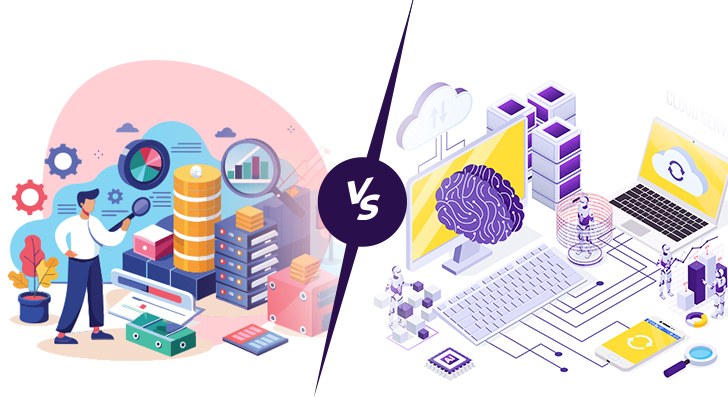The rapid growth of the digital world has resulted in the introduction of multiple new technical phrases and terms. When it comes to data, terms like data science, data analytics, big data, and machine learning are used in many official meetings, boardroom discussions, and conferences. This often results in confusion among people on the actual meaning of these terms. Many of these terms might sound similar, but each term is different from the other. Let’s understand the difference between two widely used terms— data mining and machine learning. Though both are closely related fields, they differ in their core objectives, techniques, and applications.
Data Mining
Data mining is pivotal when it comes to verticals like marketing, retail, banking, or communication. It is a knowledge discovery process that helps extract useful information from a large amount of data. Data mining is used for discovering new patterns, hidden relationships, anomalies, trends, and forecasts within the data. Researchers, analysts, data scientists, and businesses leverage data mining as a tool to uncover useful insights from large sets of data.
The chief goal of data mining is to discover information or facts that were previously unknown using complex mathematical algorithms and statistical methods. It leverages the strength of various pattern recognition techniques from machine learning to extract knowledge and discover patterns from huge data sets.
Machine Learning
A subset of artificial intelligence (AI), machine learning involves the development of algorithms that allow computers to learn on their own, improve performance over time with experience, and perform desired actions without being explicitly programmed. Machine learning applications learn from previous transactions and computations and utilize” pattern recognition” for generating reliable results.
Machine learning has a wide range of applications including fraud detection, product recommendations, traffic predictions, personal assistants like Siri and Alexa, and more.
Similarities Between Data Mining and Machine Learning
Data mining and machine learning use data to solve complex problems and the two terms are often used interchangeably. This does not come as a surprise because machine learning is, at times, used for conducting practical data mining. As insights collected from data mining can be used for teaching machines, the differences between the two concepts tend to blur. Also, both processes majorly use the same complex algorithms to discover data patterns. Nevertheless, the desired results delivered from the two processes differ from each other.
Boost Your Decision-Making with Web Data Mining Services
Differences Between Data Mining and Machine Learning
While there are a few similarities between the two terms, there are a considerable number of differences as well. Let’s understand the key distinctions between data mining and machine learning:
1. The Time of Origin
Data mining was introduced two decades before machine learning and was called Knowledge Discovery in Database (KDD). Introduced in the 1930s, the goal of data mining is to identify relationships and links between the attributes in a dataset to predict outcomes. Machine learning, on the other hand, was introduced in the 1950s and includes gaining knowledge from past data and using the acquired knowledge to make future predictions.
Data mining is a cross-disciplinary field that utilizes machine learning along with other techniques for discovering the properties of a dataset. The latter is a subset of data science that focuses on designing algorithms that can learn from data and make predictions accordingly. Thus, data mining uses machine learning but not vice versa.
2. The Purpose
Data mining helps extract knowledge from extensive volumes of data, while machine learning helps a computer learn and understand the parameters. In other words, data mining is just a method of research to arrive at a specific conclusion based on the collected data. Machine learning trains a system to carry out complex tasks and utilizes harvested experiences and data to become smarter. These algorithms can dive deeper, irrespective of the volume or variety of the data, to uncover nuggets of knowledge that might otherwise be missed by the human eye.
3. Inputs Used
Data mining depends on large quantities of structured, static, and historical data for making forecasts, uncovering patterns, and detecting anomalies for researchers and businesses. On the other hand, machine learning has the flexibility to handle both structured and unstructured, historical or real-time data, to build predictive models and make informed decisions.
4. Manual v/s Automatic
Data mining requires human intervention to interpret the discovered patterns and make decisions based on the findings. Contrarily, machine learning algorithms learn from new data and improve their performance without much human oversight. The results of data mining are useless until a human being interacts with them. Whereas human contact in machine learning is simply limited to setting up initial algorithms and is a “set it and forget it” process.
5. Learning Ability
Data mining cannot adapt or learn—something, that is the chief model of machine learning. Data mining is static and follows pre-set rules, while machine learning adjusts its algorithms according to the desired circumstances. The outputs of data mining rely on the intelligence of the users who enter the parameters; machine learning implies that the computers become smarter with every set of data entered.
6. Accuracy
Data mining and machine learning are both used for improving the accuracy of collected data. However, the evaluation of data mining is primarily limited to the way data is collected and processed. Data mining is a way to extract important insights from complex datasets and boost the predictive abilities of machine learning models and algorithms. In short, the accuracy of the outcomes is determined by the quality of the data and the algorithms used, but the results do not inherently improve without human intervention.
While data mining may miss out on multiple relationships and connections between the data at hand, machine learning does not. It recognizes the connections between important data points and delivers highly accurate conclusions, thereby shaping the behavior of the model.
7. Ways of Use
The specialties of both processes are distinctly defined. Data mining services are extensively used in the retail and ecommerce industry for understanding the buying habits of customers to develop better sales strategies accordingly. Social media plays a vital role in data mining by helping businesses collect information from customer profiles, keywords, shares, and queries of users. This assists marketers to offer appropriate promotions. The financial sector uses data mining to find opportunities for investment and determine the likelihood of a startup’s success. Collecting such information assists investors in deciding if they want to invest money in new projects or not.
Machine learning is used by companies for purposes like online customer service, self-driving cars, email spam interception, credit card fraud detection, personalized marketing, and business intelligence. MNCs like Google, Twitter, Facebook, Salesforce, Pinterest, and Yelp, all leverage a perfect blend of data mining and machine learning for multiple purposes.
Conclusion
Needless to say, there’s no conclusion for this data mining vs machine learning debate. Both the processes have their perks and are beneficial for businesses in unique ways. Besides, as the amount of data increases and more businesses want to leverage the power of predictive modelling, machine learning and data mining are here to stay. These help organizations in scaling up their decision-making and analytical abilities, which are both necessary to pull through the competition and carve a unique niche in the industry.






